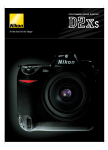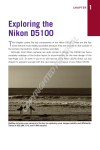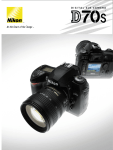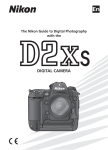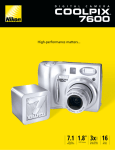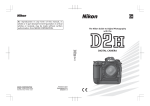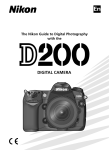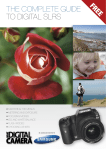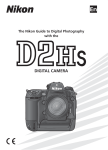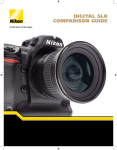Download FOCUS Enhancements D2Xs User's Manual
Transcript
Nikon Digital SLR Camera D2Xs Specifications Type Effective Pixels Image Sensor Image Size (pixels) Single-lens reflex digital camera 12.4 million CMOS sensor, 23.7 x 15.7mm; total pixels: 12.84 million Full image: 4,288 x 2,848(L), 3,216 x 2,136(M), 2,144 x 1,424(S) High-speed Crop Image: 3,216 x 2,136(L), 2,400 x 1,600(M), 1,600 x 1,064(S) 100 to 800 (ISO equivalent); HI-0.3, HI-0.5, HI-0.7, HI-1 and HI-2 available Sensitivity CompactFlash™ (CF) Card (Type I/II) and Microdrive™ Storage Media NEF (12-bit uncompressed or compressed RAW), Storage System EXIF 2.21, DCF 2.0 and DPOF compliant (uncompressed TIFF-RGB or compressed JPEG) Storage (number of frames) For details, refer to page 9 1) Single frame shooting [S] mode: advances one frame for each shutter release Shooting Modes 2) Continuous high shooting [CH ] mode: Full Image; 5 frames per second (fps)/High-speed Crop Image; 8 frames per second (fps) 3) Continuous low shooting [CL] mode: Full Image; 1 to 4 frames per second (fps) (selectable in menu)/High-speed Crop Image; 1 to 7 frames per second (fps) (selectable in menu) 4) Self-timer mode: time duration can be set 5) Mirror up mode: first press: mirror up, second press: release 1) Auto (hybrid with 1,005-pixel RGB Sensor, CMOS image sensor and White Balance external Ambient Light Sensor) 2) Manual (6 steps with fine tuning) 3) Preset (5 settings) 4) Color temperature setting in Kelvin (select from 31 steps) 5) White balance bracketing (2 to 9 frames adjustable in 10, 20, 30 MIRED steps) 2.5-in., approx. 230,000-dot, low temp. polysilicon TFT LCD with white LED LCD Monitor backlighting; Backlight/brightness adjustment available 1) Full frame, 2) Thumbnail (4/9 segments), 3) Zoom, 4) Slideshow, Playback Function 5) RGB Histogram indication, Shooting data and Highlight point display 1) Card format, 2) All frames delete, 3) Selected frames delete Delete Function NTSC or PAL (selectable in menu) Video Output USB 2.0 (Hi-Speed) (Mini-B connector) Interface FTP file transfer and PTP/IP camera control/file transfer is available with optional WT-2/2A (IEEE 802.11b/g) Wireless transmitter; FTP file transfer compatibility with WT-1/1A (IEEE 802.11b) CF Card Slot Type II: supports firmware updates via CF cards Record mode: Automatic or manual recording at shooting or playback, Voice Memo Max. recording time: 60 seconds Playback mode: Built-in speaker or Audio Video Cable File format: Mono WAV file Up to 36 characters of alphanumeric text input is available with LCD monitor Text Input and multi-selector; stored in EXIF header 1) AF Nikkor (including AF-S, DX, VR and D-/G-type): All functions possible Usable Lenses 2) D-type Manual-Focus Nikkor: All functions except autofocus and some exposure modes available 3) AF Nikkor other than D-/G-type: All functions except 3D-Color Matrix Metering II and 3D Multi-Sensor Balanced Fill-Flash possible 4) AI-P Nikkor: All functions except 3D-Color Matrix Metering II, 3D Multi-Sensor Balanced Fill-Flash and AF possible 5) Non-CPU AI Nikkor: Usable in [A] or [M] mode with Matrix Metering, Center-Weighted and Spot Metering available Indication of aperture No., after user inputs the aperture f/No. and focal length F=mm by multi-selector operation Electronic rangefinder usable with maximum aperture of f/5.6 or faster Full Image: Approx. 1.5x focal length in 35mm [135] format equivalent Picture Angle High-speed Crop Image: Approx. 2x focal length in 35mm [135] format equivalent Optical-type fixed eye-level pentaprism; Built-in diopter adjustment (-3 to Viewfinder +1m-1), Eyepiece shutter provided 19.9mm (at -1.0m-1) Eyepoint BriteView Clear Matte Screen III; supplied Type-B or Focusing Screen optional Type-E with grid Viewfinder Frame Coverage Approx. 100% (High-speed Crop mode: Approx. 97%) Approx. 0.86x with 50mm f/1.4 lens set to infinity and -1.0m-1 Viewfinder Magnification Automatic, instant-return type Reflex Mirror Instant-return type, with Depth-of-field Preview Button Lens Aperture TTL phase detection, Nikon Multi-CAM 2000 autofocus module; Autofocus Detection range: EV -1 to +19 (Right edge/Left edge AF range: EV 0 to +19) (at normal temperature [68°F/20°C], ISO 100 equivalent) 1) Single servo AF [S], 2) Continuous servo AF [C], 3) Manual focus [M] Lens Servo Focus Tracking automatically activated by subject's status in [S] or [C] AF Selectable from 11 focus areas (High-speed Crop: 9 focus areas) Focus Area 1) Single Area AF 2) Dynamic-area AF 3) Group Dynamic AF AF Area Modes 4) Dynamic-area AF with closest subject priority Focus is locked by pressing AE-L/AF-L button or lightly pressing shutter release button in [S] AF Exposure Metering System TTL full-aperture exposure metering system; 1) D-/G-type Nikkor lenses support 3D-Color Matrix Metering II using the 1,005-pixel RGB Sensor while other AF Nikkor lenses with built-in CPUs support Matrix Metering (Non-CPU lenses require manual input of lens data) 2) Center-Weighted Metering (75% of the meter's sensitivity concentrated on the 8mm dia. circle) given to 6, 10 or 13mm dia. circle in center of frame, or weighting based on average of entire frame 3) Spot Metering (3mm dia. circle, approx. 2% of entire frame); metering position can be linked to the focus area when using Nikkor lenses with built-in CPU Exposure Metering Range 1) 3D-Color Matrix Metering II: EV 0 to 20 2) Center-Weighted Metering: EV 0 to 20 3) Spot Metering: EV 2 to 20 (at normal temperature [20°C/68°F], ISO 100 equivalent, f/1.4 lens) CPU and AI (Automatic maximum aperture Indexing) Exposure Meter Coupling 1) [P] Programmed Auto with flexible program Exposure Modes 2) [S] Shutter-priority Auto 3) [A] Aperture-priority Auto 4) [M] Manual ±5 EV increments of 1/3, 1/2 or 1 EV Exposure Compensation Detected exposure value locked by pressing AE-L/AF-L button Auto Exposure Lock Auto Exposure Bracketing Number of shots: 2 to 9 frames Compensation steps: 1/3, 1/2, 2/3, or 1 EV steps Electronically-controlled vertical-travel focal plane shutter, 30 to 1/8,000 sec. Shutter in steps of 1/3, 1/2 or 1 EV, bulb X-contact only: flash synchronization at up to 1/250 sec. Sync Contact 1) Creative Lighting System: i-TTL Balanced Fill-Flash controlled by TTL Flash Control Sensor with Nikon Speedlight SB-800/600: Advanced Wireless Lighting, FV (Flash Value) Lock, Flash Color Information Communication for Auto White Balance, Auto FP High-Speed Flash Sync, Modeling Flash 2) D-TTL Balanced Fill-Flash: When used with the Speedlight SB-80DX/50DX and in accordance with the mounted lens, five-segment TTL Multi Sensor control makes available 3D Multi-Sensor Balanced Fill-Flash, Multi-Sensor Balanced Fill-Flash, and Standard D-TTL Balanced Fill-Flash 3) AA (Auto Aperture-type) Flash available when used with SB-800/80DX and lens with built-in CPU 4) Non-TTL Auto Flash (A-type Flash) with a Speedlight such as SB-800/30/27/22s etc. 5) Range-priority manual available with SB-800 1) Front-curtain sync (normal sync), 2) Red-eye reduction, Flash Sync Modes 3) Red-eye reduction with slow sync, 4) Slow sync, 5) Rear-curtain sync Lights up when flash fully charged with Speedlight SB-800/600/80DX/ Ready-light 28DX/50DX; blinks for full output warning Standard ISO hot-shoe contact with safely lock provided Accessory Shoe ISO 519 standard terminal, lock screw provided Sync Terminal Electronically controlled timer with 2 to 20 seconds duration Self-timer Depth-of-field Preview Button Stop-down lens aperture by pressing Depth-of-field Preview Button Via 10-pin remote terminal Remote Control NMEA 0183 (ver. 2.01) Interface standard supported with GPS 9-pin D-sub cable (optional) and GPS Cable MC-35 (optional) English, French, German, Spanish, Italian, Dutch, Swedish, Supported Languages Simplified Chinese, Korean, Japanese (selectable in menu) Rechargeable Li-ion Battery EN-EL4a (11.1V DC), Power Requirements Quick Charger MH-21, AC Adapter EH-6 (optional) Battery Monitoring System The LCD monitor on the camera back displays the following information about the EN-EL4a battery: 1) Remaining charge (%); 2) No. of shots taken since last charge; 3) Calibration status (Recommended/Not required); 4) Battery life (5 stages) 1/4 in. (ISO 1222) Tripod Socket Approx. 6.2 x 5.9 x 3.4 in. (157.5 x 149.5 x 85.5mm) Dimensions (W x H x D) Approx. 2.4 lbs (1,070g) Weight (without battery) Rechargeable Li-ion Battery EN-EL4a, Quick Charger MH-21, Body Cap, Supplied Accessories* Camera Strap AN-D2Xs, Audio Video Cable EG-D2, USB Cable UC-E4, LCD Monitor Cover BM-3, Battery Chamber Cover BL-1, Type-B Focusing Screen, PictureProject software CD-ROM Wireless Transmitter WT-2/2A, Extended Range Antenna WA-E1, AC Adapter Optional Accessories EH-6, Type-E Focusing Screen, Magnifier DG-2, Antifog Finder Eyepiece DK17A, Rubber Eyepiece Cup DK-19, Eyepiece Correction Lens DK-17C series, Magnifying Eyepiece DK-17M, Right-Angle Magnifying Viewing Attachment DR-5, Speedlight SB-800/SB-600/SB-R200, Capture NX Software, Camera Control Pro Software, Image Authentication Software. Focus Lock *Supplied accessories may differ in each country or area. The following memory cards have been tested and approved for use with the D2Xs. • SanDisk Corporation: 128MB-8GB (SDCFB, SDCFB(Type II), SDCF2B(Type II), SDCFH (Ultra II), and SDCFX (Extreme III) • Lexar Media Corporation: 128MB-8GB (Entry-level, 40x, Professional 40x with WA, Professional 80x with WA) • Microdrive™: 340MB, 512MB, 1GB, 2GB, 4GB, 6GB For more details, please contact the respective media card manufacturer. CF cards not listed above are not guaranteed to operate properly. Macintosh® is a registered trademark or a trademark of Apple Computer Inc. in the United Microsoft® and Windows® are either registered trademarks or trademarks of Microsoft Corporation in the United States and/or other countries. Images in viewfinders, on LCDs and monitors Products and brand names are trademarks or registered trademarks of their respective companies. CompactFlash™ is a trademark of SanDisk Corporation. States and/or other countries. shown in this brochure are simulated. Specifications and equipment are subject to change without any notice or obligation on the part of the manufacturer. June 2006 c 2006 NIKON INC. TO ENSURE CORRECT USAGE, READ MANUALS CAREFULLY BEFORE USING WARNING YOUR EQUIPMENT. SOME DOCUMENTATION IS SUPPLIED ON CD-ROM ONLY. 1300 Walt Whitman Road, Melville, N.Y. 11747-3064, USA. www.nikondigital.com Printed in Japan Code No. 6CE60165 (0605A) Ad DSLR-D2XS-30-05/06 DIGITAL SLR CAMERA The True Nature of Photography The goal was straightforward; take a truly versatile professional tool to new levels of response, handling efficiency and fine control over the results. The strategy was clear; apply the feedback gained by working hand in hand with professional photographers in the field to refine the already stellar operation and performance of Nikon’s flagship digital SLR camera. At the heart of the system is a proven 12.4 million-pixel image sensor, advanced image processing engine, and optimized systems that blend high levels of resolution with superb image quality, pure color rendition, and class-leading speed. The 11-area AF system is tuned to deliver even finer precision and higher performance. An improved view in High-speed Crop mode makes composition easier. The host of enhancements also includes significantly increased battery life per charge, an improved menu interface, and a new color calibrated 2.5-inch LCD with ultra-wide viewing angle. The Nikon D2Xs hits the mark – freeing photographers to explore the true nature of photography. 2 3 Smooth control and usability Vic Huber Performance you can trust Ergonomic design and button layout Magnesium alloy body with enhanced sealing system The size, layout and operation of each customizable button, control and function is designed for intuitive operation and feedback, minimizing the need to remove the eye from the viewfinder while shooting. This combines with instant, predictable response to free the photographer to concentrate on composition. Operation remains consistently comfortable for either horizontal or vertical orientation. The convenient Function button on the front of the body can be programmed for simpler switching such as in and out of High-speed Crop mode when using continuous shooting. The eye-level viewfinder features frame coverage of virtually 100% and a 19.9mm eyepoint. Information bars along the bottom and right edges display the current white balance mode, image quality and size settings, ISO setting and more. Updated for the D2Xs, the viewfinder also features an improved view within the High-speed Crop mode frame for faster and easier composition. Housed in a lightweight yet highly durable magnesium alloy body, the D2Xs is built to perform reliably under the tough working conditions of professional photographic assignments. Nikon’s enhanced sealing system protects every possible seam and exposed part, making the body resistant to dust and drops of water. A new locking mechanism holds the USB cable’s connector securely and prevents it from being accidentally pulled out of the USB port. “Every decision I make as a photographer impacts the outcome of an image. The D2Xs handles intuitively and makes excellent technical decisions for me so I can focus on the dynamics of the image.” Image quality mode: RAW (NEF) • Lens: AF-S VR Zoom-Nikkor 24-120mm f/3.5-5.6G ED-IF • Exposure mode: [A] 1/40 second, f/13 • White balance: Cloudy • Sensitivity: ISO-equiv. 100 Lithium-ion battery system with even greater power Passive quality — Uncompromising craftsmanship and optimum in-field efficiency Understanding the importance of intuitive handling and tough reliability in the field, Nikon designed every button, control and function for maximum ease of access, intuitive operation, handling efficiency and reliability. Meet the professional digital SLR solution truly equipped to extend creative freedom and business productivity; the Nikon D2Xs. Valuable feedback from information displays The D2 Xs’s new 2.5-inch high-resolution LCD with up to 27x magnification permits effective evaluation of sharpness, expression and exposure, and quick confirmation of exposure using the Histogram or RGB Histogram displays. The color-coded menu displays and large type have been refined for easier recognition and access. The top and rear control panels are also designed to convey essential status and settings information at a glance. Menus that maximize practicality and versatility Custom Settings menus are grouped according to basic features for fast and easy access. Up to 4 complete selections of Custom Settings can be stored in the camera’s memory bank, allowing instant switching to the optimized selection for the given assignment. In addition to displaying the last 8 settings made using the Shooting menus and Custom Settings menus, further evolution of the Recent Settings list adds the ability to delete the current settings, or lock them to prevent accidental changes. A new menu option also allows camera settings to be saved to or loaded from a memory card, making it convenient to share settings between D2Xs cameras that will be used in similar conditions. A new feature available from the Shooting menu is the ability to download up to 3 custom tone curves for a wider range of gamma choice to accommodate the diverse demands of different assignments. New The new EN-EL4a rechargeable lithium-ion battery retains the same form, but features significantly increased capacity that delivers enough power for up to 3,800 shots* per charge. It can be recharged at any time or any level, features extended service life, and performs well at low temperatures. The system’s real-time status display gives accurate feedback on the percentage of remaining battery charge, the number of shots taken since the last charge, the overall status of service life, as well as notification when calibration is recommended. The D2Xs can also be powered by EN-EL4 batteries, and EN-EL4a batteries are compatible with earlier Nikon D2 series cameras. *Based on Nikon test conditions. See instruction manual for complete details. Proven shutter unit for reliability and speed Mechanical systems throughout the camera are enhanced to fully support the speed, precision and durability required by professionals. The double-bladed shutter unit, refined from the field-proven systems on high-end Nikon SLRs, is tested to well over 150,000 cycles. It employs a mirror balance mechanism that completes its motion cycle and reaches a full stop with virtually no mirror bounce, achieving maximum stability and speed as well as smoother AF detection. Custom Settings menus C R a a1 a2 a3 a4 a5 a6 a7 a8 Bank select Menu reset Autofocus AF-C mode priority AF-S mode priority Group dynamic AF Lock-on AF activation Focus area Illum Focus area Vertical AF-ON b b1 b2 b3 b4 b5 b6 b7 c c1 c2 Metering/exposure ISO auto ISO step value EV step Exposure comp. EV Exposure comp. Center weight Fine tune exposure Timers/AE & AF lock AE lock AE-L/AF-L c3 c4 c5 d d1 d2 d3 d4 d5 d6 Auto meter-off Self-timer Monitor off Shooting/display Shooting speed Maximum shots Exp. delay mode File No. Seq. Cntrl Panel / finder Illumination e e1 e2 e3 e4 e5 e6 e7 e8 Bracketing/flash Flash sync speed Flash shutter speed AA flash mode Modeling flash Auto BKT set Manual mode bkting Auto BKT order Auto BKT selection f f1 f2 f3 f4 f5 f6 f7 f8 Controls Center button Multi selector Photo info/playback FUNC. button FUNC. + command Command dials Buttons and dials No CF card? 4 5 Instant response Accurate exposure metering Instant response & ultra-short shutter lag 3D-Color Matrix Metering II The D2Xs is designed with instant start-up and optimized systems that maximize all-round performance for immediate response. As a result, the D2Xs is ready to shoot whenever a decisive moment may arise. This performance combines with the industry’s shortest shutter release time lag of a mere 37 milliseconds to realize high-resolution photography without compromise. To achieve optimum exposure for each shot, Nikon’s acclaimed 1,005-pixel RGB Exposure/Color Matrix Metering Sensor and advanced algorithms determine the brightness and size of highlight areas, while at the same time evaluating all brightness, color, contrast, selected focus area and subject-to-camera distance information. The results are then referenced against a comprehensive onboard database of scenes acquired from actual photographs before high-speed processing calculates the final value to deliver consistent and dependable automatic exposure. Refinements to the D2Xs add the availability of 3D-Color Matrix Metering II in High-speed Crop mode, while also optimizing the areas calculated for using Center-weighted metering, Spot metering and i-TTL Flash Control. Fast shutter speeds Shutter speeds from 30 seconds to 1/8,000 second can be selected in 1/3, 1/2 or 1 EV steps, with Bulb exposure also available. Flash synchronization is possible using speeds up to 1/250 second, or up to 1/8,000 second when using AUTO FP High-Speed Sync with an SB-800, SB-600 or SB-R200 Speedlight. 1,005-pixel RGB Sensor Exposure quantization algorithm Exposure evaluation algorithm Final exposure value Correction Value Estimates overexposed areas Modes and controls for optimizing exposure High-speed continuous shooting Active quality — Instant response, pinpoint precision and optimum exposure Capturing the moment with exceptional image quality demands instant response, high-speed operation, precise focus and accurate exposure. Ground-up development aimed at satisfying these professional needs continues to evolve in the further refined 11-area The D2Xs offers versatility in its selection of continuous shooting speed modes. In addition to taking a total number of 60 consecutive shots, capture 12.4 megapixel files at 5 frames per second for 17 consecutive RAW (NEF) or 22 JPEG shots. Or, use the exclusive High-speed Crop mode to shoot at 8 frames per second for 29 consecutive RAW (NEF) or 38 JPEG shots. High-speed Crop mode uses data from the central area of the sensor that results in a picture angle comparable to that of a 35mm lens with double the focal length. This provides a useful option when shooting sports, animals or other fast-moving objects from a distance. AF system, advanced exposure metering and optimized subsystems of the Nikon D2Xs. 1,005-pixel RGB Sensor Modes include [P] Programmed Auto with Flexible Program, [S] Shutter-priority Auto, [A] Aperture-priority Auto, and [M] Manual. Manual exposure compensation is available from -5 to +5 EV in 1/3, 1/2 or 1 EV steps. Manual and Automatic ISO sensitivity control New Sensitivity can be manually set between ISO-equivalent 100 and 800 in increments of 1/3 EV, or boosted using the HI-0.3, HI-0.5, HI-0.7, HI-1 or HI-2 settings when high sensitivity is a priority. The 3 settings between 800 and HI-1 are newly added to give the D2Xs finer control over sensitivity. Automatic sensitivity adjustment helps achieve optimum exposure while freeing the photographer to concentrate on composition. Offering greater control over the range within which AUTO ISO operates, the D2Xs provides settings to specify the maximum value to which the function can increase sensitivity and the minimum shutter speed at which AUTO ISO will operate. High-speed focusing 11-area AF system with 9 cross-type AF sensors Vic Huber “The combination of race cars, helicopters, radio communications and weather conditions makes an assignment like this most difficult. Despite such complexity, the advanced technology of the D2Xs gives me the confidence to focus on composition while it handles the rest – instantly, reliably and precisely.” Updated to perform even faster and with greater precision in the D2 Xs, the 11-area AF system employs Nikon’s advanced Multi-CAM 2000 AF Sensor Module. Of these 11 widely spread AF sensors, 9 are cross-type sensors positioned in the logical rule-of-thirds array. All 9 cross-type sensors remain active when using High-speed Crop mode. The following selection of operating modes is designed to ensure maximum flexibility and optimum performance in different shooting situations. • Single-area AF allows the photographer to lock the focus using any one of the 11 AF spot sensors. Single-area AF has been tuned for the D2Xs to reduce AF hunting for low-contrast subjects. • Dynamic AF with Focus Tracking and Lock-on™ follows the subject if it moves from its original position once a priority focus area is selected, and ensures accurate focusing by shifting instantly and automatically to the focus area into which the subject has moved. Subject acquisition and tracking capability are improved for the D2Xs, while new options for controlling the timing of the focus tracking lock-on make it easier to adjust for shooting different types of scenes and action. • Closest Subject Priority Dynamic AF automatically identifies one or more focus areas as needed, to capture the subject the AF system determines to be closest to the camera. • Group Dynamic AF combines groups of AF sensor activity into logical patterns. Both Dynamic AF and Closest Subject options are available and are useful when shooting moving subjects that remain in a specific area of a framed scene in which a lot of peripheral action might also be taking place. Multi-CAM 2000 AF Sensor Module 6 7 Image quality mode: RAW (NEF) • Lens: AF-S VR Zoom-Nikkor 24-120mm f/3.5-5.6G ED-IF • Exposure mode: [A] 1/40 second, f/3.5 • White balance: Direct sunlight • Sensitivity: ISO-equiv. 100 Viewfinder image in High-speed Crop mode Capturing the expression 12.4 megapixel DX format image sensor Creative in-camera effects The DX Format CMOS sensor captures 12.4 million effective pixels per image, producing 4,288 x 2,848-pixel images with the high resolution and sharp detail needed for commercial assignments. High-speed 4-channel independent data output contributes to impressive levels of image quality and system speed. Image Overlay merges a pair of selected RAW files to create a new composite image within the camera as a RAW, JPEG or TIFF file. Multiple Exposure creates a single image from up to 10 exposures, and can be used with the camera’s built-in interval timer. High-performance, high-resolution image processing engine CONVENTIONAL PROCESSING SYSTEM Nikon’s most powerful image processing engine to date combines color Image Sensor General ASIC (Image processing pipeline) independent analog pre-conditioning with improved digital image processing A/D conversion algorithms. This innovative system delivers images with a natural and appealing look that benefits from faithful color reproduction Quantum and realistic transitions Quantum Error Error between areas of different color and tone. Image quality cannot be maintained D2Xs PROCESSING SYSTEM Optimized WB gain distribution & A/D conversion RGB 4-channel output Image Sensor ASIC (Image processing pipeline) Faithful color reproduction More precise pipeline quantization Digital quality — Flexible and accurate white balance control Innovation to produce the best results and limitless creative possibilities Advanced Auto White Balance (AWB) and Auto Tone Control (ATC) systems effectively handle complicated lighting conditions, achieving optimum white balance along with refined color and tone reproduction. Manual white balance mode selections include Color Temperature mode for directly setting Kelvin color temperature from 31 values between 2,500K and 10,000K. Preset mode provides quick selection from 5 white balance settings that may be saved to match the lighting conditions in known venues. Sharp resolution and pure color fidelity rendered with finer gradations and smoother transitions demonstrate the professional performance under the hood. This unsurpassed image quality skillfully combines with complete control, flexibility and customization, freeing photographers to create productively; only in the Nikon D2Xs. Expanded color rendering options New Nikon’s advanced color reproduction system combines 3 available color modes and corresponding color profile choices to offer a range of color treatments to match specific assignments and workflow environments. The D2Xs adds a new Black & White (sRGB) color mode choice to further expand the in-camera creative possibilities. Image quality mode: RAW (NEF) • Lens: AF-S VR Zoom-Nikkor 70-200mm f/2.8G ED-IF • Exposure mode: [M] 1/125 second, f/7.1 • White balance: Selected color temperature (5000K) • Sensitivity: ISO-equiv. 100 New high-quality 2.5-inch LCD New The D2 Xs is fitted with a new 2.5-inch high-resolution LCD, which boasts an ultra-wide 170-degree horizontal and vertical viewing angle. Each LCD is calibrated at the factory to ensure consistent color fidelity. Nicolaas de Bruin & Melita “Fine gradations, consistently smooth transitions and unfailing color fidelity is essential to my work. The D2 Xs makes it possible to accurately portray what I envisioned.” Extended creative abilities In-camera image trimming New RAW, TIFF and JPEG images taken using the D2Xs can be trimmed within the camera to produce images of reduced display sizes ranging from 640 x 480 to 2,560 x 1,920 pixels. The smaller files that result can help improve workflow efficiency by eliminating the time required to download and perform software editing within a computer. Wireless Transmitter WT-2/2A* (optional) The Wireless Transmitter WT-2/2A supports IEEE 802.11g for maximizing transfer speeds while maintaining backward compatibility with IEEE 802.11b. It may be configured for a wide variety of network Wireless LAN Concept Diagram and security protocols, and also enables WT-2/2A illustrated (The WT-1/1A supports only FTP and IEEE 802.11b) wireless control of the camera from a Infrastructure mode Ad-hoc mode Data transfer using a wireless LAN Data transfer using a notebook computer access point with a wireless LAN card installed computer via the Camera Control Pro software option. Access Point Versatile operation means that it is (AP) possible to automatically transfer each Personal Camera Personal Camera Control Pro computer* FTP server FTP server computer* Control Pro image as it is shot, or manually select images for transfer. The transfer proceeds invisibly as normal camera operation Image transfer Image transfer continues and it is automatically retried Camera Camera Control Control if disrupted. Files may be automatically erased from the CompactFlash memory card once successfully transferred. The IEEE 802.11b IEEE 802.11b/g Data Data D2Xs is fully compatible with the WT-1/1A. transfer transfer IEEE 802.11b IEEE 802.11b/g PTP/IP FTP *FTP server unnecessary when using PTP/IP Wireless LAN accessory attached (Wireless Transmitter WT-2/2A) *The WT-2/1 is sold in countries where governments approve the use of 13 frequency channels. The WT-2A/1A version is sold in countries where governments limit use to 11 frequency channels. Memory Card Capacity and Image Quality/Size The following table shows the approximate number of pictures that can be stored on a 1 GB card at different image quality and size settings. Image quality RAW (NEF) + JPEG Fine 3, 4, 5 Hi-speed Crop: Off Hi-speed Crop: On Image File No. of Buffer File No. of Buffer size size 1 images 1 capacity 2 size 1 images 1 capacity 2 L6 25.1 MB 36 16 14.2 MB 64 28 M6 S6 L6 22.6 MB 20.7 MB 22.2 MB 41 45 41 16 16 16 12.8 MB 11.8 MB 12.6 MB 72 79 73 28 28 28 Normal 3, 4, 5 M6 S6 20.9 MB 20.0 MB 44 47 16 16 11.9 MB 11.4 MB 78 82 28 28 RAW (NEF) + JPEG Basic 3, 4, 5 L6 M6 S6 20.7 MB 20.1 MB 19.6 MB 45 47 48 16 16 16 11.8 MB 11.4 MB 11.2 MB 79 82 84 28 28 28 RAW (NEF) 4 — 19.2 MB 49 17 10.9 MB 86 29 RAW (NEF) + JPEG 1 All figures are approximate. Size of JPEG files varies with scene recorded. 2 Maximum number of frames that can be stored in memory buffer. Drops when Long Exp. NR is on, Advanced noise reduction options Real-time noise reduction that can be applied during image processing may be augmented by long exposure and high ISO noise reduction options, available via menu settings. when ISO sensitivity is set to HI-0.3 or higher, or when High ISO NR is on and Custom Setting b1 (ISO auto) is on or ISO sensitivity is ISO 400 or higher. 3 Total for RAW (NEF) and JPEG images. 4 Figures assume RAW compression is set to RAW (NEF). Selecting Comp. RAW (NEF) decreases file size of RAW (NEF) images by approximately 40 to 50 percent; although number of exposures remaining does not change, number of images that can be recorded increases. Buffer capacity drops by one. 5 Figures assume JPEG compression is set to Fixed size. Selecting Optimal quality increases file size of JPEG images by up to 80 percent; number of images and buffer capacity drops accordingly. 6 Applies to JPEG images only. File size of RAW (NEF) images cannot be changed. 8 9 The NEF advantage Original image Image quality mode: RAW (NEF) • Lens: AF-S Zoom-Nikkor 28-70mm f/2.8D ED-IF • Exposure mode: [M] 1.30 seconds, f/8 • White balance: Incandescent • Sensitivity: ISO-equiv. 100 Thumbnail and “Instruction Set” RAW Thumbnail and “Instruction Set” Image Data Processing Adjust.1 RAW Image Data Processing Adjust.2 Image Data Processing Adjust.3 ••• NEF (Nikon Electronic Format) satisfies everchanging photographic needs with extended range and versatility. Each NEF file contains not only the RAW image data captured by the image sensor, but also a thumbnail image and an all-important “Instruction Set” of the recorded original settings from the time the image was captured. The RAW data is never altered, regardless how many times the file is opened and new renditions saved. Working with NEF files Thumbnail and “Instruction Set” RAW Image Data Processing Information Save images in RAW (NEF) format, or write to TIFF or JPEG formats The RAW data within a NEF file is preserved unchanged regardless how many times it is processed in Capture NX. Capture NX (Optional) New The highly versatile, elegantly simple photo editing solution Image refined with Capture NX Workflow quality — Featuring a new interface that provides easier access to power ful and visually intuitive enhancement tools, Nikon’s Capture NX software helps photographers to tap the full potential of NEF images. This new software also adds support for JPEG and TIFF processing to satisfy a broader range of photofinishing needs and applications. • Lens correction tools 3 original tools help expand imaging possibilities for a wider variety of lenses by compensating for lens effects. Vignette Control can reduce the effect of marginal lumination. New Distortion Control can reduce pincushion and barrel distortion effects. Color Aberration Control uses digital processing to detect color fringing caused by chromatic differences in lens magnification, and automatically reduce it by aligning colors at the edges of the image. U Point™ technology Software versatility and elegance help realize your envisioned results Professional workflow demands efficiency and consistency under differing conditions, and must yield the finest quality while providing the flexibility to edit freely as the assignment demands. Nikon’s latest software offerings combine all this and more to help achieve maximum quality with minimal effort while working with high-resolution images from the D2Xs. U Point™ is patented technology exclusive to Capture NX that allows easy selection of image areas according to points of interest. Its interface turns the application of effects and enhancements into an intuitive photographic process not found in the complicated computer graphic procedures of typical photo editing software. U Point™ combines with the extensive Nikon Capture toolbox for NEF to offer an unsurpassed set of features. And, its powerful photo image processing and editing tools can also be applied to JPEG and TIFF files from most any digital camera. • D-Lighting D-Lighting allows photographers to manipulate shadows and highlights while maintaining mid-tones to produce optimized results from images with areas of under- or overexposure. Choose from D-Lighting HQ when quality is the priority, or D-Lighting HS for high-speed results. Camera Control Pro — New Remote control over the D2Xs (Optional) Operate and control most settings for the D2 Xs remotely from a computer, with the option to also download images to the computer’s hard disk drive while shooting. Image Authentication Software — New Protects the integrity of valuable data (Optional) When the authenticity of an image needs to be proven, Nikon’s exclusive Image Authentication function may be used to indicate not only whether the actual image has been tampered with, but also if any changes have been made to date and GPS information. Dallas Carroll “There is just so much more that I can do with Nikon software. It really unlocks the potential within each image and allows me to make creative decisions quickly and with ease. With the D2 Xs and Nikon software, creativity just flows.” • RAW adjustments Photo gr a p he r s c a n fre e ly ma nipulate white balance, color balance, tone curves and noise reduction for NEF files after shooting. The results can be saved and multiple renditions created, all with the assurance that the original image data is permanently retained. • Selective tools PictureProject — Capture NX newly offers a range of selective tools for applying over 25 enhancement styles, including the Brush, Lasso, Marquee, Gradient and Fill/ Remove tools. The supplied PictureProject software provides fast and easy access to powerful image management, editing and sharing tools. Fast, easy and powerful (Supplied) • Other features Additional tools that enhance Capture NX’s unique capabilities include: Browser, Batch Processing, Edit List, Red-Eye Reduction, Version, Advanced Noise Reduction and other useful functions. 10 11 Dallas Carroll Profile: Combining the sensitivities of his diverse artistic experience with a wealth of computer software knowledge, Dallas Carroll brings the sophistication of an artist to the technical realm of digital imaging. While working on various corporate advertising projects, he continues to adopt the latest imaging tools as he pushes the limits of creativity. Image quality mode: RAW (NEF) • Lens: AF-S VR Zoom-Nikkor 24-120mm f/3.5-5.6G ED-IF • Exposure mode: [A] 1/6 second, f/8 • White balance: Cloudy • Sensitivity: ISO-equiv. 100 Image refined with Capture NX Image quality mode: RAW (NEF) • Lens: AF-S VR Zoom-Nikkor 24-120mm f/3.5-5.6G ED-IF • Exposure mode: [A] 1/100 second, f/11 • White balance: Cloudy • Sensitivity: ISO-equiv. 100 Original image Nicolaas de Bruin & Melita Profile: Fashion/beauty photographer Nicolaas de Bruin and makeup artist/hair stylist Melita collaborate to produce photographs for fashion and commercial clients. Their work appears regularly in magazine fashion and beauty editorials, and in a range of major advertising campaigns. http://www.ndbm-photo.com Image quality mode: RAW (NEF) • Lens: AF-S VR Zoom-Nikkor 70-200mm f/2.8G ED-IF • Exposure mode: [M] 1/125 second, f/9 • White balance: Selected color temperature (4500K) • Sensitivity: ISO-equiv. 100 Image quality mode: RAW (NEF) • Lens: AF-S VR Zoom-Nikkor 24-120mm f/3.5-5.6G ED-IF • Exposure mode: [M] 1/60 second, f/8 • White balance: Flash • Sensitivity: ISO-equiv. 100 Vic Huber Profile: Image quality mode: RAW (NEF) • Lens: AF-S Zoom-Nikkor 28-70mm f/2.8D ED-IF • Exposure mode: [M] 2 seconds, f/8 • White balance: Incandescent • Sensitivity: ISO-equiv. 100 A veteran of more than twenty years, Vic Huber's photography career ranges from magazine editorial work to national and global advertising campaigns. While the core of his work lies in automotive photography, 12 his passion for his art is equally demonstrated in his landscape, travel and model photography. http://www.vichuber.com 13 Image quality mode: RAW (NEF) • Lens: AF-S VR Zoom-Nikkor 70-200mm f/2.8G ED-IF • Exposure mode: [M] 1/125 second, f/6.3 • White balance: Selected color temperature (4500K) • Sensitivity: ISO-equiv. 100 Vic Huber “I need a system that can match any photo opportunity that arises. I need to know the equipment I have can capture the moment exactly the way I envision it, and the D2Xs has the system capabilities to do so.” The Creative Lighting System Image quality mode: RAW (NEF) • Lens: AF-S VR Zoom-Nikkor 24-120mm f/3.5-5.6G ED-IF • Exposure mode: [M] 1/125 second, f/8 • White balance: Flash • Sensitivity: ISO-equiv. 400 The D2Xs works seamlessly with SB-800, SB-600 and SB-R200 Speedlights, delivering the full benefits of i-TTL flash control’s advanced monitor pre-flash, accurate bounce-flash measurement, and comprehensive wireless operation. The SB-800 and SB-600 Speedlights also feature a Wide-Area AF-Assist Illuminator tailored to the D2Xs’s 11-area Multi-CAM 2000 AF Sensor Module, as well as Auto Zoom flash coverage. Speedlight mode settings Master: Flash canceled Remote A: Manual Remote B: Manual Remote C: Manual i-TTL Flash Control Building on the accuracy of the monitor pre-flash, the brighter, shorter i-TTL preflash enables more precise evaluation of flash exposure to achieve outstanding results from better automatic flash balance. • Advanced Wireless Lighting System Exclusive technology does away with the need for cables and flash meters to provide a totally flexible on-location lighting solution. With an SB-800 or SU-800 serving as the Commander, up to 3 remote groups consisting of any number of SB-800, SB-600 or SB-R200 Speedlights may be freely arranged for total lighting control. Independent mode settings (i-TTL, AA, A, M, Repeating flash and Flash canceled) are available for each group as well as on the Commander, along with full i-TTL control based not only on general output ratios for each group, but also on the measured subject brightness. As a result, each flash output ratio can be set, even if a remote unit is repositioned. Flash compensation within each group can also be adjusted during operation, with settings easily made and confirmed on the Commander’s large dot-matrix LCD. There’s also a choice of 4 frequency channels to minimize the risk of interference with other photographer’s flashes. Image quality mode: RAW (NEF) • Lens: AF-S DX Zoom-Nikkor 17-55mm f/2.8G ED-IF • Exposure mode: [M] 30 seconds, f/22 • White balance: Cloudy • Sensitivity: ISO-equiv.100 System quality — M B C • Flash Color Information Color information transmitted to the camera’s body allows the system to compensate for the effects of voltage and flash duration on the color of an image. • FV (Flash Value) Lock The flash equivalent of AE Lock allows photographers to change composition while maintaining a desired flash value. • AUTO FP High-Speed Sync Speedlights can be automatically fired at shutter speeds up to 1/8,000 second, providing a dominant fill flash for effective separation of subject and background, even when shooting in bright conditions. Nikkor lenses and the Creative Lighting System enhance creative possibilities Tight integration with all components of Nikon’s Total Imaging System assures compatibility across the lineup of Nikkor lenses for A • Modeling Flash A 1-second (approx.) stroboscopic burst is fired, enabling the photographer to visually check for shadows and reflective objects, and to assess overall lighting prior to shooting. SB-800 access to the best available optics. Full support for Nikon’s advanced Creative Lighting System removes all limits from creative lighting options. Flexibility to meet a wide range of needs and true Nikon quality in every image; with the D2Xs. SB-600 Nikon Close-up Speedlight Commander Kit R1C1 Accessories Nikkor lenses AF-S VR Micro-Nikkor 105mm f/2.8G IF-ED Continuing the tradition of employing the Nikon F lens mount, the D2Xs offers seamless compatibility with the comprehensive lineup of high-quality AF and AF-S Nikkor lenses favored by professionals for their superb color, razor-sharp images and consistently excellent autofocus performance. DX Format digital SLR photographers also have the benefit of choosing from the growing family of custom-designed DX Nikkor lenses, which provide wider picture angles, higher performance, and outstanding center-to-edge-to-corner image quality. The use of manual Nikkor lenses is also supported. The world’s first macro lens equipped with SWM (Silent Wave Motor) and VR II (Vibration Reduction) technologies also includes Nano Crystal Coat, Extra Low Dispersion (ED) glass and Internal Focusing (IF). Incorporating Nikon VR technology in a Micro-Nikkor lens improves hand-held close-up photography by minimizing the effects of camera shake on picture sharpness, and by providing a stable viewfinder image for easier composition. Note: When used with the D2Xs or any DX Format SLR, all AF, AF-S and DX Nikkor lenses have a picture angle comparable to 1.5x that of 35mm [135] format. Nikon offers a full array of accessories to customize system setups for optimum performance matched to the requirements of the assignment. • The AC Adapter EH-6 provides support for the use of AC power sources. • Remote control accessories supported by the built-in 10-pin connection terminal include the Remote Cord MC-22/MC-30/MC-36 and Modulite Remote Control Set ML-3. • The optional Type-E with grid guide is interchangeable with the supplied Type-B Focusing Screen. • The DR-5 Right-Angle Viewing Attachment can be rotated and easily switches to 2x magnification for greater precision in framing and checking focus. • NMEA 0183 (ver. 2.01) compliant GPS units can be connected via the optional GPS cable (MC-35) to record latitude, longitude, altitude, heading (direction) and UTC (Coordinated Universal Time) information for each shot. • Pictures can be printed directly to PictBridge-compatible printers. System Chart Function Compatibility Chart (IX-Nikkor lenses cannot be used) Focus mode Camera setting Lens/accessory CPU lenses 1 Non-CPU lenses 11 Type G or D AF Nikkor 2 AF-S, AF-I Nikkor PC-Micro Nikkor 85 mm f/2.8D 4 AF-S / AF-I Teleconverter 7 Other AF Nikkor (except lenses for F3AF) AI-P Nikkor AI-, AI-S, or Series E Nikkor12 AI modified Nikkor Medical Nikkor 120 mm f/4 Reflex Nikkor PC-Nikkor AI-type Teleconverter 18 TC-16A AF Teleconverter PB-6 Bellows Focusing Attachment19 Auto extension rings (PK-series 11A, 12, or 13; PN-11) Exposure mode P A S M Metering system S C M (with electronic rangefinder) M √ √ √ √ √ √ — √3 — √8 √5 √8 √ √ — √ √6 √ √ √ — — √3 √3 √9 √9 √ √ √ — √ √3 — √ 10 √ √ √ — √ √3 3D Color 3 — √ 10 √ — √ 13 — √ 14 √ 15 — — — — √8 √ — √5 √8 √8 √ √ √ √ √ — — — — — √ 16 √ 13 √ 17 √ 13 √ 13 — — — — — — — — √ 14 √ 14 — √ 15 √ √ 15 √ 15 — √8 √ — √ 20 — — √ — √8 √ — √ 13 — — √ 1 IX-Nikkor lenses cannot be used. 2 Vibration Reduction (VR) supported with VR lenses. 3 Spot metering meters selected focus area. 4 The camera’s exposure metering and flash control systems do not work properly when shifting and/or tilting the lens, or when an aperture other than the maximum aperture is used. 5 Electronic rangefinder cannot be used with shifting or tilting. 6 Manual exposure mode only. 7 See teleconverter manual for list of compatible lenses. 8 With maximum effective aperture of f/5.6 or faster. 9 When focusing at minimum focus distance with AF 80–200 mm AI-type Teleconverter f/2.8S, AF 35–70 mm f/2.8S, new AF 28–85 mm f/3.5–4.5S, or AF 28–85 mm f/3.5–4.5S lens at maximum zoom, in-focus indicator may be displayed when image on matte screen in viewfinder is not in focus. Adjust focus manually until image in viewfinder is in focus. 10 With maximum aperture of f/5.6 or faster. 11 Some lenses cannot be used. 12 Range of rotation for AI 80–200 mm f/2.8S ED tripod mount limited by camera body. Filters cannot be exchanged while AI 200–400 mm f/4S ED is mounted on camera. 13 If maximum aperture is specified using Non-CPU lens data option in shooting menu, aperture value will be displayed in viewfinder and top control panel. 14 Can be used only if lens focal length and maximum aperture are specified using Non-CPU lens data option in shooting menu. Use spot or center-weighted metering if desired results are not achieved. 15 For improved precision, specify lens focal length and maximum aperture using Non-CPU lens data option in shooting menu. 16 Can be used in manual exposure modes at shutter speeds slower than 1/125 s. If maximum aperture is specified using NonCPU lens data option in shooting menu, aperture value will be displayed in viewfinder and top control panel. 17 Exposure determined by presetting lens aperture. In aperture-priority auto exposure mode, preset aperture using lens aperture ring before performing AE lock or shifting lens. In manual exposure mode, preset aperture using lens aperture ring and determine exposure before shifting lens. 18 Exposure compensation required when used with AI 28–85 mm f/3.5–4.5S, AI 35–105 mm f/3.5–4.5S, AI 35–135 mm f/3.5–4.5S, or AF-S 80–200 mm f/2.8D. See teleconverter manual for details. 19 Requires PK-12 or PK-13 auto extension ring. PB-6D may be required depending on camera orientation. 20 Use preset aperture. In manual exposure mode, set aperture using focusing attachment before determining exposure and taking photograph. Note: DX Nikkor lenses are designed exclusively for Nikon digital SLRs and their DX Format Sensor. When selecting a lens for use on a Nikon D-Series SLR, pay special attention to the angle of view that is possible with each selected focal length. All Nikon D-Series SLRs will provide the same angle of view with each DX Nikkor and AF Nikkor lens. The shorter focal length DX Nikkor optics provide the widest available angle of view. Remote Cord MC-36 (0.85m)/ MC-30 (0.8m)/MC-22 (1m) Rubber Eyecup DK-19 Connecting Cord MC-23 (0.4m) Antifog Finder Eyepiece DK-17A Modulite Remote Control Set ML-3 Magnifying Eyepiece DK-17M Adapter Cord MC-25 (0.2m) Eyepiece Correction Lens DK-17C Series (-3,-2,+1,+2m-1) MC-36 MC-30 Extension Cord MC-21 (3m) MC-22 Eyepiece Magnifier DG-2 GPS Cable MC-35 Speedlight SB-800 SB-600 Wireless Speedlight Commander SU-800 Nikkor lenses Focusing Screen Type-B*/Type-E Wireless Remote Speedlight SB-R200 Nikon Close-up Speedlight Commander Kit R1C1 Eyepiece Adapter DK-18 Right-Angle Magnifying Viewing Attachment DR-5 CompactFlash™ card** Battery Chamber Cover BL-1* AV Cable EG-D2* PC Card adapter** Personal computer** or Microdrive™** CF Card reader** • Capture NX • Camera Control Pro • Image Authentication • PictureProject* USB Cable UC-E4* GPS unit** TV monitor** AC Adapter EH-6 Quick Charger MH-21* Rechargeable Li-ion Battery EN-EL4a* Wireless Transmitter WT-2/2A (Battery Chamber Cover BL-2 supplied) Extended Range Antenna WA-E1 Printer** 14 15 *Supplied accessories **Non-Nikon products









